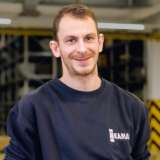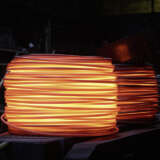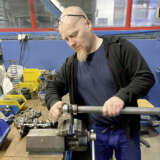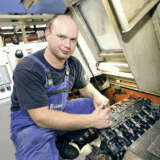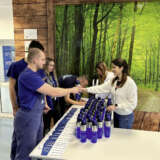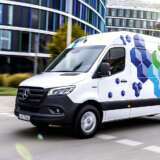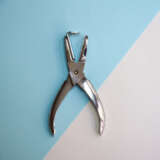A strong
connection –
KAMAX
and steel
Without it, our plants would not be able to do anything at all: steel. Our most important raw material is the basis of each and every one of our fasteners. That is why we have decided to take a closer look at where we get our steel, the paths it takes to get here, and the things that distinguish it.
When it comes to steel, we have a rule: from the region – for the region. Be it in Europe, Asia, or the USA – we always strive to use steel sourced in the region where it is used. There is an important reason why we do this: steel is heavy, and transporting it is an expensive and elaborate process. And KAMAX uses a great deal of steel. Worldwide, we process up to 18,000 tons of steel – every month. By way of comparison: that is roughly equivalent to the weight of 3,000 elephants. Steel is generally transported in the form of coils that are placed on top of one another and held together by steel strips. A single coil can weigh as much as three tons.
Collaborating and fine-tuning
With the huge volumes of steel that it processes, it is essential that KAMAX have reliable suppliers. Their number cannot be so small that the company becomes too dependent on any particular supplier, yet their number cannot be too large, to ensure that the entire process does not become too unwieldy. Our colleagues in the USA work with three primary suppliers, while in Europe the company obtains 80 percent of its steel from respected wire rod manufacturers. Several companies supply our plants in China.
As different as the cultures might be in the regions where we operate, the steel market functions pretty much the same way around the globe. For KAMAX, it is important to establish long-term relationships and create a reliable supply chain. Whenever possible, we try to account for uncertainties like energy prices when we negotiate conditions and supply volumes.
Something else that is important: development partnerships. We work with manufacturers to test new alloys and new processes. Perhaps we need some special steel properties for a new product, or would like to make our supply chain more cost-effective. With a development partner in Europe, for example, we developed a market-ready process that allows us to drastically reduce the energy required for the tempering and quenching process.
As simple as steel might appear at first glance, there is actually nothing simple about it. Every steel mixture, or alloy, is unique. In order to achieve the desired properties – the desired corrosion resistance, for example – substances such as nickel and chrome are precisely measured out to the gram and added. Every KAMAX bolt and screw requires its own special formula. The processing also plays a role. The interplay of alloy, temperature, cooling, and forming is carefully defined right down to the tiniest detail. Even the temperature is so important that fractions of a degree can make a difference to the steel’s hardness. At KAMAX, we require the perfect medium between hardness and toughness.
Raw materials
Various raw materials are required to produce steel, including iron ore, coal, and limestone.
Smelting and Cleaning
The raw material mixture is combined with a specific volume of coke in a furnace and heated to a very high temperature, until the iron ore has been melted. Due to the fact that there are still unwanted substances in the iron ore, chemical processes are employed to filter these out.
Forming and cooling
The pure iron ore can now be shaped into the desired form, such as plates, strips, or coils. The iron ore must then be cooled, a process that can take hours or even days.
On the way to green steel
Although ecological sustainability has only played a modest role in steel production to date, there is a great deal of potential to improve here. Steel is a material that can theoretically be recycled an infinite number of times (as long as the required level of purity is maintained).
This leaves us with the topic of production. There are two different procedures, known as production routes, for manufacturing steel. The conventional route uses a blast furnace. The first simple furnaces were created around 5,000 years ago. The simple fact that coal is used to remove oxygen from the iron ore means that this route releases CO₂. And that is even before accounting for the tremendous amount of energy required. The furnaces are powered by gas, and as a result, an average of two tons of CO₂ are released for every ton of steel produced.
An alternative method involves the electric arc furnace (EAF) route. Its history stretches back to France in the early 20th century. This route involves smelting high-quality steel scrap and iron ore. If an environmentally friendly method is employed to remove oxygen from the iron ore, for example the use of hydrogen, and if this is done using renewable energy, emissions can be reduced to 0.8 tons of CO₂ per ton of steel.

The wire in the manufacturing process at high temperatures.
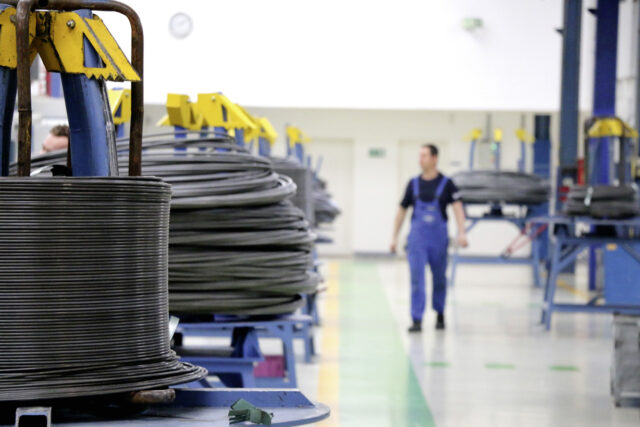
The raw material shortly before processing in our cold forming department.
No easy task
There are advantages and disadvantages to both routes. When the process is carried out in accordance with the aforementioned specifications, the EAF route is both more sustainable and more flexible. However, it is not possible to produce all grades of steel with this method, nor is it particularly efficient. Blast furnaces have an advantage as far as steel quality is concerned, but are at a disadvantage in the respect that they must be continuously operated and require a great deal of energy. A study conducted by the International Energy Agency (IEA) reveals just how much: according to this study, steel production alone accounts for approximately 25 percent of all emissions generated by industry. At KAMAX, approximately 80 percent of emissions are accounted for by the steel it has purchased.
Changing the method of production is no easy task – it requires massive investments that cannot be made quickly. That is why, as a steel consumer, we are making efforts in various areas simultaneously. We are continually working to increase the share of recycled steel and steel produced via the EAF route that we use. In addition, we are developing our own processes and procedures with the goal of saving both energy and materials. And finally, we are working closely with our development partners to make our production processes more efficient, and therefore to conserve resources.
KXpress

